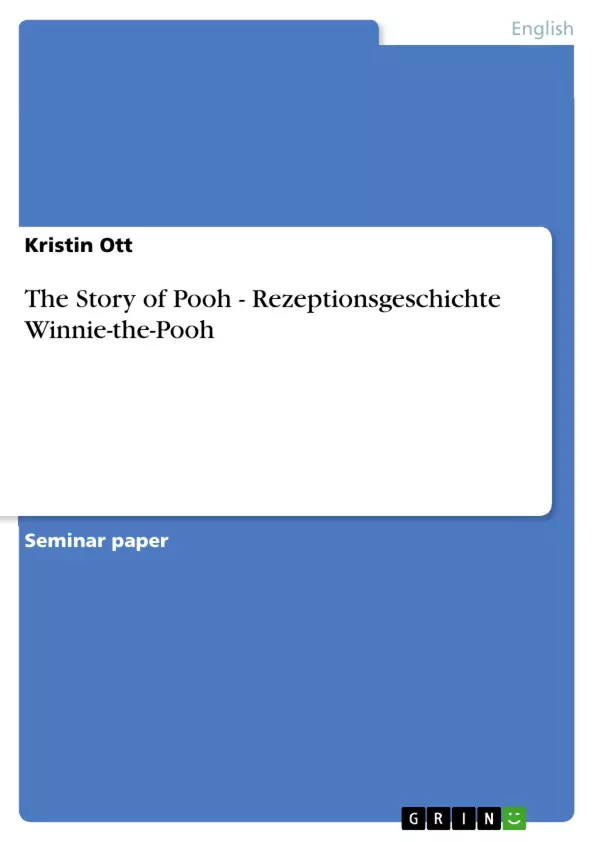“A. A. Milne’s Winnie-the-Pooh stories have delighted generations of children since they first appeared over 70 years ago”1. Both Winnie-the-Pooh books, published in the 1920s2, sold extremely well from the start of publication and have done so ever since. Nowadays numerous editions and spin-offs exist, and virtually every shop sells something that features the chubby yellow bear and his friends from the Hundred Acre Wood. When the copyright was sold to Disney in 1961, even more people around the globe were to become acquainted with Winnie. And last but not least The Tigger Movie and Piglet’s Big Adventure ensured not only commercial success but also an ever growing fan-community, most of it based on the WorldWideWeb. Over the last twenty years various ‘scholars’ have attempted to partake in the success of the Pooh stories – by writing more or less necessary works of The Wisdom of Pooh, with probably the most famous one being Hoff’s Tao of Pooh, published in 1982. The Story of Pooh seems to be one of everlasting success – a merchandise haven – with Pooh having replaced even Micky Mouse as Disney’s favourite character.
1 Back cover text of Alan Alexander Milne, The Complete Winnie-the-Pooh, (London: Dean, 2002).
2 Winnie-the-Pooh first published in 1926, The House at Pooh Corner first published in 1928
Table of Contents
- 1. INTRODUCTION
- 2. WHEN IT WAS FIRST PUBLISHED
- 3. FAMILY FORTUNES
- 4. DISNEY INCORPORATED
- 5. THESE ARE THE WRONG SORT OF BEES – THE
- NECESSITY FOR YELLOW SELF-HELP BOOKS
- 6. CONCLUSION
Objectives and Key Themes
This paper explores the reception history of Winnie-the-Pooh, examining the evolution of its popularity over several generations. The paper investigates the origins of the stories and the impact of their publication on both the author and his son, Christopher Robin. It also examines the role of Disney in bringing Pooh to a global audience and discusses the ongoing popularity of the characters and the merchandise associated with them.
- The origins and publication history of Winnie-the-Pooh
- The relationship between the author, his son, and the creation of the stories
- The impact of Disney on the popularity of Winnie-the-Pooh
- The ongoing cultural significance of Winnie-the-Pooh
- The commercial success of the Pooh stories and merchandise
Chapter Summaries
- Chapter 1: INTRODUCTION: This chapter provides an overview of the ongoing popularity of Winnie-the-Pooh, highlighting the widespread impact of the stories and their continued appeal across generations.
- Chapter 2: WHEN IT WAS FIRST PUBLISHED: This chapter examines the life and influences of A.A. Milne, focusing on his childhood, his literary career, and the inspiration behind the creation of Winnie-the-Pooh. It also explores the historical context of the publication of the stories, including the impact of World War I on children's literature.
- Chapter 3: FAMILY FORTUNES: This chapter delves into the relationship between A.A. Milne and his son, Christopher Robin, discussing the impact of the stories on their personal lives and the lasting legacy associated with Christopher Robin's name.
Keywords
The key terms and concepts explored in this work include Winnie-the-Pooh, A.A. Milne, Christopher Robin, children's literature, reception history, Disney, commercial success, cultural significance, and merchandise.
- Arbeit zitieren
- Kristin Ott (Autor:in), 2003, The Story of Pooh - Rezeptionsgeschichte Winnie-the-Pooh, München, GRIN Verlag, https://www.grin.com/document/17277



